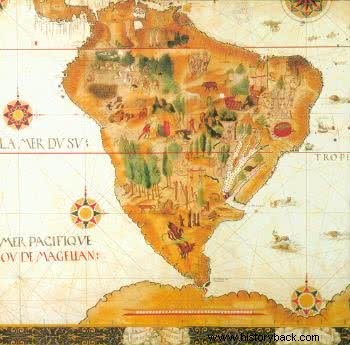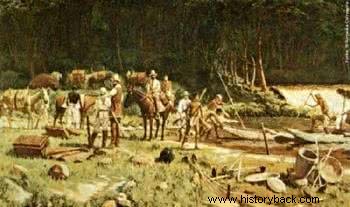The Colonial Brazil , in the History of Brazil, is the period that comprises the period from 1530 to 1822.
This period began when the Portuguese government sent to Brazil the first colonizing expedition led by Martim Afonso de Souza.
In 1532, he founded the first settlement, Vila de São Vicente, on the coast of the current state of São Paulo.
Pre-Colonial Period
Soon after the arrival of the Portuguese in the new territory, the first economic activity revolved around the exploitation of pau-brasil, which exists in large quantities on the Brazilian coast, mainly in the northeast of the country. This period became known as the Pau-Brasil or pre-colonial cycle.
The exploitation of pau-brasil was merely extractive and did not give rise to an effective occupation.
The work of felling trees and preparing the wood for shipment was done by the indigenous people and a few Europeans who remained in trading posts on the coast.
Exploited in a predatory way, the trees close to the coast disappeared as early as the 1520s.
See also:Pre-Colonial PeriodThe beginning of colonization
 Map of Brazil in the Colonial Period
Map of Brazil in the Colonial Period
Several expeditions were sent by Portugal, aiming to reconnoitre the entire Brazilian coast and fight French pirates and traders.
The most important were those commanded by Cristóvão Jacques (1516 and 1526), who fought the French.
Martim Afonso de Sousa (1532) also fought French piracy. In the same way, he installed in São Vicente, the first village with a sugar mill.
To colonize Brazil and guarantee land tenure, in 1534, the Crown divided the territory into 15 hereditary captaincies. These were immense plots of land that stretched from the coast to the limit established by the Treaty of Tordesillas.
These lots were donated to captains (donatários), belonging to the Portuguese nobility who, on their own, promoted local defense and colonization.
Sugar production was chosen because it was a very popular product in Europe at that time.
It was in the northeast of the country that the sugar industry reached its highest level of development, mainly in the captaincies of Pernambuco and Bahia. In the 16th and 17th centuries, these regions became the dynamic center of Brazil's social, political and economic life.
See also:Sugarcane CycleThe General Government
The General Government system was created in 1548, by the Crown, with the objective to organize the administration colonial.
The first governor was Tomé de Souza (1549 to 1553), who received from the Portuguese government a set of laws to be applied in the colony. These determined the administrative, judicial, military and tax functions of the General Government.
The second governor general was Duarte da Costa (1553 to 1558) and the third was Mem de Sá (1558 to 1572).
In 1572, after the death of Mem de Sá and his successor Dom Luís de Vasconcelos, the Portuguese government divided Brazil into two governments whose unification only came back in 1578:
- Government of the North, based in Salvador
- Government of the South, based in Rio de Janeiro
In 1580, Portugal and all its colonies, including Brazil, came under the rule of Spain, a situation that lasted until 1640. This period is known as Iberian Unification .
In 1621, still under Spanish rule, Brazil was again divided into two states:the State of Maranhão and the State of Brazil. This division lasted until 1774, when the Marquis of Pombal decreed the unification.
The social formation of Colonial Brazil
 Representation of a village in the colonial period
Representation of a village in the colonial period
Fundamentally, three major ethnic groups, the indigenous, black Africans and white Europeans, mainly Portuguese, entered the formation of Brazilian colonial society.
The Portuguese who came to Brazil belonged to various social classes in Portugal. Most were formed by elements of the gentry and the people.
It is also necessary to take into account that the indigenous tribes had different languages and cultures. Some were enemies with each other and this was used by Europeans when they wanted to make war against the Portuguese.
Likewise, blacks brought as slaves from Africa had distinct beliefs, languages and values and did not constitute a homogeneous people. However, all this was absorbed by the Portuguese and indigenous people.
In Colonial Brazil, the engenho was the dynamic center of all social life. This made it possible for the “lord of the big house” to concentrate around himself a large number of individuals and to have the maximum authority, prestige and local power.
Around the mill lived the mulattoes, usually the sons of the lords with enslaved black women, the priest, the enslaved blacks, the overseer, the sugar master, free workers, etc.
Threats to Portuguese Domain
In the first years after the discovery, the presence of French pirates and traders on the Brazilian coast was constant.
The French invasion took place in 1555, when they conquered Rio de Janeiro, founding the "Antarctic France" there, being expelled in 1567.
In 1612, the French invaded Maranhão, where they founded the "Equinoctial France" and the village of São Luís, where they remained until 1615, when they were expelled again.
British attacks in Brazil were limited to raids by pirates and privateers who plundered some ports. They invaded the cities of Santos and Recife and the coast of Espírito Santo.
The two Dutch invasions of Brazil took place during the period when Portugal and Brazil were under Spanish rule. Bahia, seat of the General Government of the state of Brazil, was invaded, but the Dutch presence lasted only a short time (1624-1625).
In 1630, the captaincy of Pernambuco, the largest sugar center in the colony, was invaded by Dutch troops.
The conquest was consolidated in 1637, with the arrival of the Dutch ruler Count Maurice of Nassau. He managed to establish Dutch rule in Pernambuco and extend it to almost the entire northeast of Brazil.
The city of Recife, the administrative center, was urbanized, sanitized, paved, bridges, palaces and gardens were built. Mauritius of Nassau's rule came to an end in 1644, but the Dutch were not expelled until 1654.
The century of gold and diamonds
The search for precious metals was always the dream of the colonizers. The discoveries began in the 1690s, in the region of Minas Gerais.
From there it spread to various parts of the national territory. In the 18th century mining was the main source of wealth in the metropolis.
The Gold and Diamond Cycles were responsible for profound changes in colonial Brazil, with urban growth and commerce.
The crisis of the colonial system
In 1640, Brazil's income from Brazilian trade was essential for Portugal. Therefore, it began to exercise stricter control over tax collection and economic activities, even banning trade with foreigners.
The discontent with the economic policy of the metropolis gave rise to some revolts, among them:
- Beckman's Revolt (1684), in Maranhão
- War of the Emboabas (1708-1709), in Minas Gerais
- War of the Peddlers (1710), in Pernambuco
At the end of the 18th century, movements aimed at freeing the colony from Portuguese rule began, including:
- Min Confidence (1789)
- Bahia Conjuration (1798)
At the beginning of the 19th century, the situation created by the Napoleonic Wars caused the change of the seat of the Kingdom to Brazil. In 1815, with the elevation of Brazil to the category of United Kingdom, the territory ceases to be a colony and, later, the Independence of Brazil is carried out in 1822.
There are more texts on this subject for you :
- Exercises Colonial Brazil
- Brazilian Culture
- Slavery in Brazil
- Indigenous Slavery in Colonial Brazil
- Engenho in colonial Brazil
